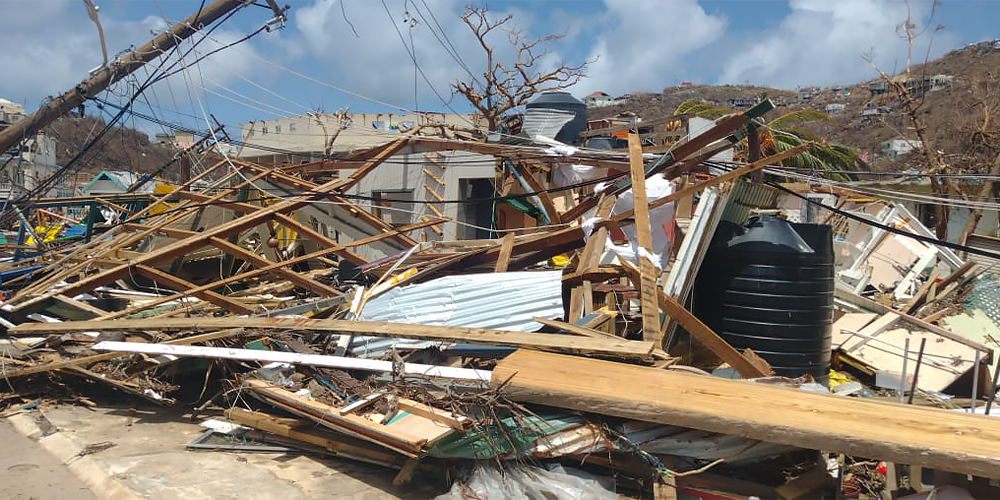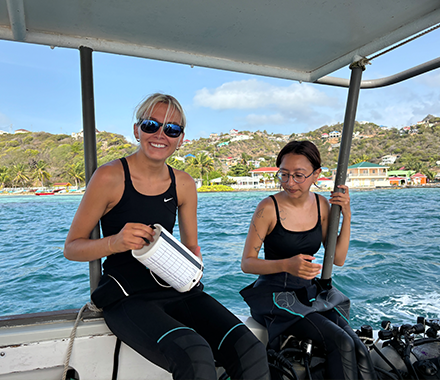
Photo Courtesy of Chantale Bégin
Just a few weeks ago, Union Island — just three miles from end to end with a population of less than 3,000 people — had been an idyllic study abroad locale for 16 USF students in a tropical marine ecology course. For two weeks in June, the students had conducted underwater research mapping fragile coral reefs in the Caribbean waters off its shores, learning from local conservationists and living in a small town where they soaked up invaluable lessons from residents.
Chantale Bégin, a Professor of Instruction in USF’s Department of Integrative Biology, has led summer study abroad classes to the small island multiple times as part of the program. Before departing for each trip, the students train as scientific divers so they can complete their research safely and effectively, contributing valuable data to global efforts to track the health of coral reefs.
They returned to Tampa just two weeks before Hurricane Beryl slammed into the island as a Category 4 storm, leaving complete devastation and the local partners to the USF program struggling to survive in destroyed houses with no roofs, water, or electricity, and a lack of communication infrastructure. Bégin and her students have since been circulating information on how to help the local community that, just weeks ago, had given USF students the experience of a lifetime.
Dr. Bégin's study abroad group is working through international non-profit Fauna & Flora to aid the Union Island Environmental Alliance, a local conservation organization that is the partner for the USF study abroad program on the island. "Katrina Coy, who heads the organization and has been working to preserve the fragile island’s environment, remains on the island living in the remnants of a destroyed house," Bégin said.
“Union Island is in a terrible state after Beryl passed. Literally, almost the whole island is homeless.”
“Union Island is in a terrible state after Beryl passed. Literally, almost the whole
island is homeless,” Coy said in a video message that was delivered to the BBC recently
via Starlink satellites.
The students spent their time on Union Island mapping and photographing coral reefs
to create sophisticated 3D models that would allow the tracking of the reef’s health
over time. However, it won’t be clear for some time exactly how much live coral is
left — or the markers the students placed so another class could return in a couple
of years to take updated photographs — after the storm, Bégin said.
But what is certain is that in their experience abroad, USF students captured the
last days of an island that will be changed forever.
A Life-Changing Journey
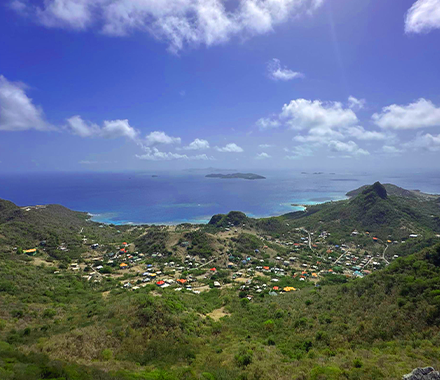
Photo Courtesy of Chantale Bégin
It’s a 12-hour journey from Tampa, via Miami, to Union Island. The USF students left on June 3, enduring two flights and a four-hour ferry ride in rough seas to get to a tiny island between Saint Vincent and Grenada. Their preparation for the study abroad experience began long before the journey with training for the dive certifications and online coursework so they would recognize the native coral and fish around the island.
Once the students arrived, they were welcomed to a small village with a hotel, a dive shop, local eateries, and a few small businesses. The students worked in an open-air classroom on their computers after their dives and quickly made friends with the local wildlife — a stray cat and the friendly dogs who followed them around the island and napped in the classroom.
“A lot of my students have never left the U.S. and they travel to the Caribbean — not to go to some resort but rather to the real Caribbean, staying in a small hotel and interacting with the community,” Bégin said.
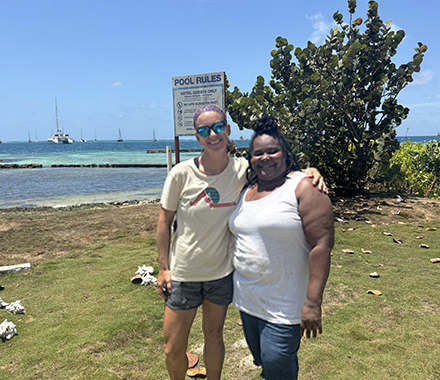
Chantale Begin and Katrina Coy
Photo Courtesy of Chantale Bégin
Bégin said most of her previous study abroad programs in the Caribbean were at research centers, but Union Island is a unique experience because the students can interact with local residents. In their off hours, the students bike and hike around the island, visit local shops, and eat in restaurants with long tables intermingling with locals. Their photos catch images of a tranquil turquoise bay dotted by sailboats and ringed by colorful houses and of wild geckos, sea turtles, giant hermit crabs, tortoises, and cattle which roam the hillsides.
“We biked up the steep foothill to Mt. Olympus and saw yet another incredible view of Chatham Bay! Seeing all of the beautiful sailboats was a treat, and a reminder of my dream to one day live on one of them in a serene bay just like this one,” wrote Sydney Tritschler, a senior majoring in marine biology, in one assignment for the class. “We chatted up here for a bit about our plans for the future, and how our time here has encouraged us to believe in the big dreams we had.”
Now, Tritschler is among the USF students who have been sharing pictures and information to raise support for Union Island. “It’s absolutely insane seeing the hotel where we stayed at not even having a roof on it. The pavilion where we took our classes is completely gone,” she said.
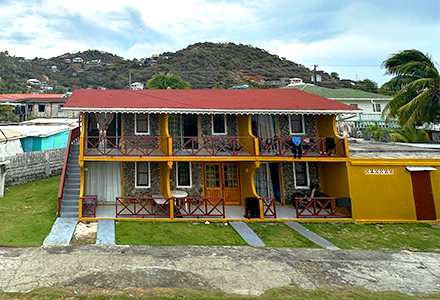
Kings Landing - Before
Photo Courtesy of Chantale Bégin
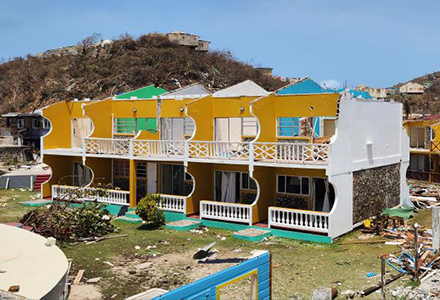
Kings Landing - After
Photo by Katrina Coy
An Environment in Distress
Union Island was already having a difficult year due to its nature as a volcanic island with no natural freshwater resources. The Union Island Environmental Alliance has worked to advance rainwater storage practices, but, “This year is experiencing a particularly bad drought,” Bégin said. “Their only source of water is rainwater." UIEA had been working to increase rainwater collection and storage, but there just is not enough fresh water on the island. Water was being carried by ferry from St. Vincent before the hurricane. “While we were on the island there was a town hall meeting to discuss options to the water crisis, including the possibility of building a water desalination plant in the future,” she said.
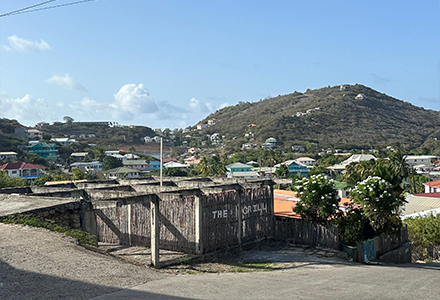
Union Island - Before
Photo Courtesy of Chantale Bégin
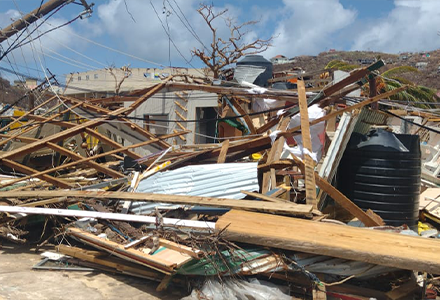
Union Island - After
Photo by Katrina Coy
Coy — who in May had delivered a presentation at the United Nations headquarters in
New York, a first for the small island community — spent part of one day’s session
talking to the students about the difficulties in running a community-based environmental
organization, finding financial support, and keeping the organization running smoothly
on few resources.
The USF students spent another day at a local elementary school teaching children
about marine ecosystems and conservation. “So many lasting connections were made between
children grades 2-5, including 'pinky promises' to remain BFF's forever,” one student
wrote in an assignment for the class. “The sheer amount of excitement from the kids
made for an incredible experience.”
Twice a day, the students conducted dives as part of a photogrammetry project, meticulously plotting out sections of the reef and placing scale markers before taking thousands of photos to be fed into software that turned the images into a high-resolution, 3D model of the reef. These models also provide insight into the abundance of fish, urchins, baby coral, algae, and other organisms that are indicators of reef health.

USF World Global Network student coordinator and integrative biology major, Tatiana Restrepo
The students also collected data on the abundance of coral, algae, fish, and invertebrates using standards of the Global Coral Reef Monitoring Network — which means their data not only could help inform local government and non-profits on reef conservation but also would be helpful to scientists around the world monitoring threats to reef health. Reefs everywhere, including the ones off Union Island, are at risk due to coral bleaching in excessively warm waters and climate change.
“The most urgent thing is that the humans on Union are safe, but soon I hope that we may be able to return, look at our plots, and assess the impact of the hurricane on the reef,” Bégin said. “Hurricanes do damage to coral reefs through wave action, especially in shallow water. There’s excess freshwater and runoff from the massive storms; there’s sediment from the runoff. There might be a lot of coral mortality, but you can’t assess that until you get back in the water,” she added.
Tatiana Restrepo, an international student at USF from Colombia and USF World student employee majoring in marine biology and environmental science at USF, described her time on Union Island as a transformative one that left her excited to pursue a career in marine biology. “After finishing scuba diving for the day, I found myself wanting to go to sleep because I couldn’t wait to start again the next day,” the rising senior said.
After leaving Union Island, Restrepo kept in touch with some of the people she met,
including girls at the elementary school who wanted to stay connected to her via WhatsApp.
“We became a part of the community,” Restrepo said. “We developed really good connections
and relationships with the people there.”
After the hurricane hit, she was thankfully able to check on her new friends, who
sent pictures of the destruction. “They said they are OK, but they don’t have food
or shelter and were leaving for other islands,” Restrepo said. “It’s truly heartbreaking.”
Katrina Sandefer contributed to this report. For more information on how to help Union Island, visit Fauna & Flora.
